Turkmenistan: the country and its people
 |
| Take a good look at this map of Central Asia (south of Russia, west of China, and east of Turkey) and see where Turkmenistan is located. Turkmenistan is one of several countries that were Soviet Republics before the USSR broke up in 1991. I lived and worked in a small village, Ruhabat, down the road from the capital, Ashgabat. |
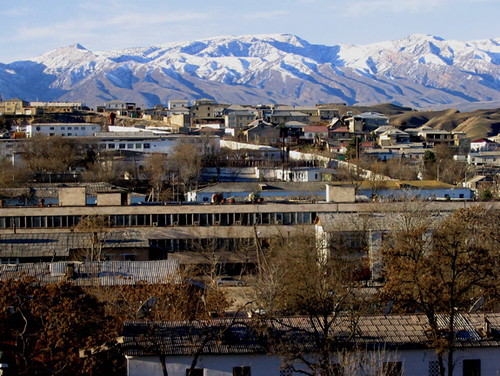 |
| Photo by Jane Bardon |
| Facing
south towards the
mountains that separate Turkmenistan and
Afghanistan. It snowed twice while I was in country, and the hottest
summer temperature
was 50+ degrees Centigrade (over 120 degrees Fahrenheit). In the
foreground are the older buildings of
Ashgabat. For a view of the newer ones, keep on scrolling down.
|
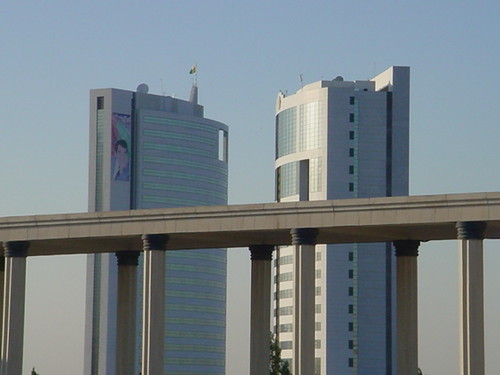 |
| Photo by Leo Deon |
| The Ministry of Gas and Oil. |
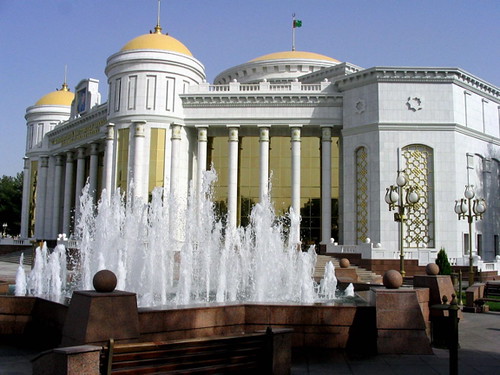 |
| Photo by Jane Bardon |
| Another
government
building. White marble and gold were paired almost
all the
time with flowing fountains, showing off the wealth and prosperity of
the Turkmen government...
|
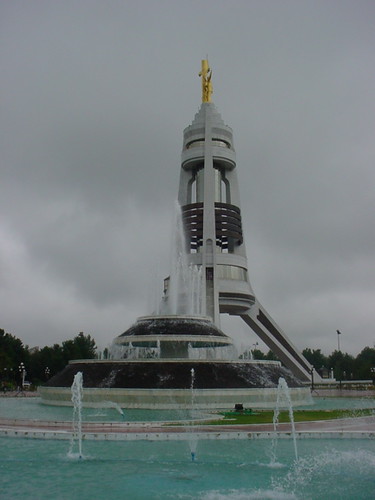 |
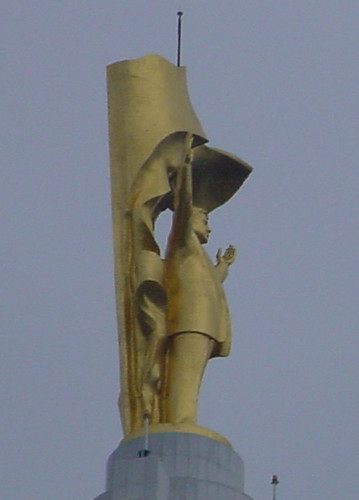 |
| Photos by Leo Deon | |
| ...and the glory of its president, Saparmyrat Nyazov, self-proclaimed "Father of All Turkmen", or "Turkmenbashy". I'm sure you have all heard about this monument that commemorates the country's neutrality. Atop is a golden statue of the president that rotates throughout the day to continuously face the sun. | |
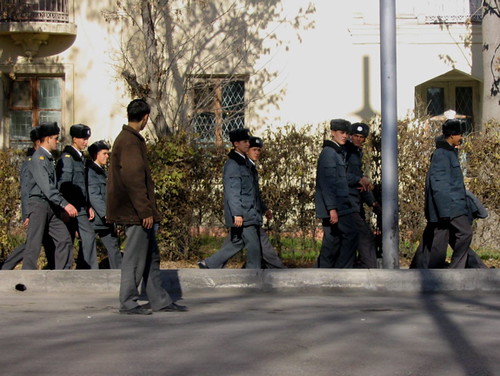 |
| Photo by Jane Bardon |
| He
controlled his country with the visible presence of the national
army and the silent network of secret
police and informants who allowed gross human rights violations,
silencing of opposition parties, and the
presence of corruption on every level of government.
|
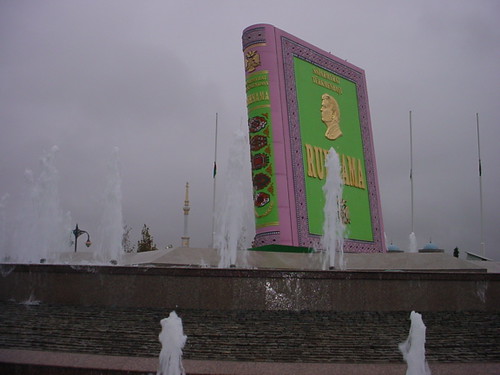 |
| Photo by Jane Bardon |
| This is a large model of the book the president wrote, the Ruhnama ("book of the soul"), that every child in school has to study and memorize. President Nyazov wrote it in a historically narrative style, recounting a romanticized history of the Turkmen people, implying that the president had spiritual authority to lead his people into the "golden age". This 15 foot tall model opens up every evening with lights and music (on the level of Disney Spectacular) and imparts one passage of the book to those who gather to listen. |
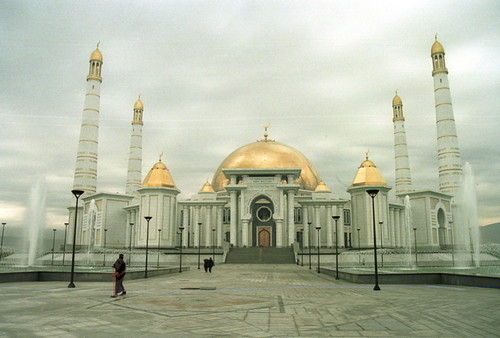 |
| Here is the largest mosque
in Central
Asia (as of 2004), built during the time I was in country, by the
president, for the
president's use during major Muslim holidays. Islam is the
state religion, though not many people are devout followers. Under
the Soviet Union, religion was not allowed; now, only the oldest
generation pray regularly or attend Friday services. At this
particular mosque, the president did not have passages from the Koran
inscribed on the minarets or the interior walls, but passages from the
Ruhnama. There were some mosques in Turkmenistan where this
blasphemy did not exist.
|
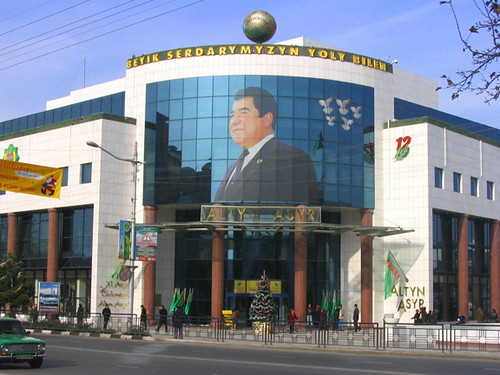 |
| Photo by Jane Bardon |
| Pictures of the president were plastered everywhere, on every public surface, in stores, classrooms, government buildings, and private homes. This is a retail mall on a major street in Ashgabat. "Altyn Asyr" means "golden century". |
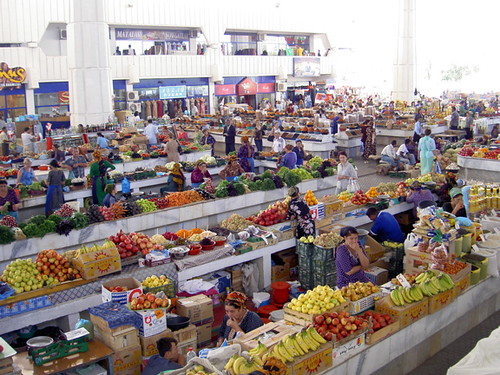 |
This
is the Russian Bazaar, located
in the heart of the capital, in walking distance to the seat of
government, as well as the Peace Corps office. Here is one of
the only places where you can find anything you need, including local
and
foreign imports of fresh produce, meats, grains, dairy, and spices,
textiles, furniture, sports equipment, CDs and DVDs, books and office
supplies, Turkmen souvenirs and black market money changers. The
government rate was $1=5,000manat; the black market rate, while I was
there, was approximately $1=25,000manat. One Snickers candy bar cost
8,000m; one
kilo of potatoes cost 4,000m. You couldn't find real peanut butter
in country (a favorite care package item), and bananas were costly
treats
(8,000m/each).
|
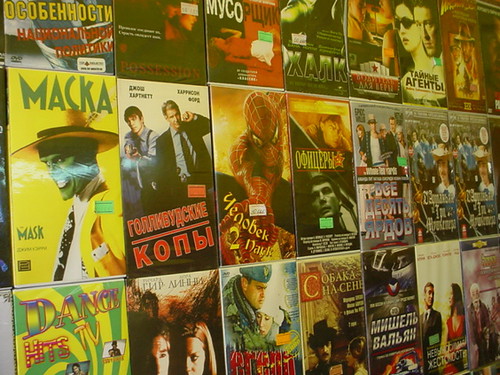
|
| Photo by Leo Deon |
| Here is a sampling of the bootlegged Russian-dubbed DVDs available. Every Turkmen family owns a TV and most have satellite television. My host father was a fan of American action movies (Jean Claude Van Damme, Arnold Schwarzenegger, and Jackie Chan were all cultural icons); I also saw Disney cartoons with my host brother and sister, and BBC newscasts and romantic comedies dubbed in Russian and Turkmen while my family was out. |
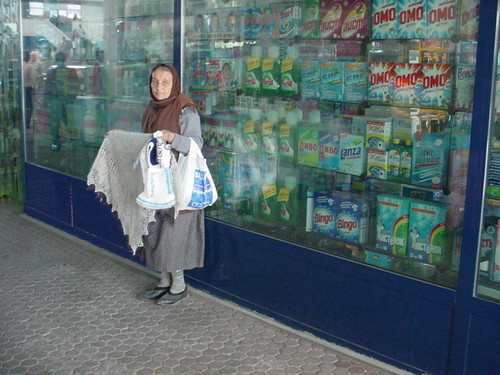 |
| Photo by Leo Deon |
Most
imports came from Turkey, our
neighbor to the west and economic paragon. During
the Soviet Union's reign of power, Russians made up approximately 40%
of the population,
staying mostly in large cities. Now the Russian population is
considerably less due to the Turkmen governmental and societal bias
towards the formerly suppressed Turkmen people. The Russian language is
still spoken by the intellectual elite, and most educated Turkmen are
bi-lingual; now, however, schools only teach Turkmen, and ethnic
Russians are penalized greatly if they are not fluent in the national
language.
|
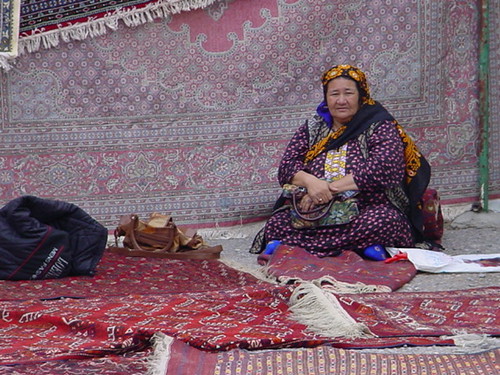 |
| Photo by Leo Deon |
| Here an old Turkmen "dayza" (a term referring to an older women, translatable to "aunt") sells Turkmen carpets, one of the main sources of pride in Turkmen culture. Red is the traditional color, and different patterns represent different regions and tribes throughout the country (five main ones). When Turkmen tribes were nomadic, the carpet was one of their only pieces of furniture; even now, they do everything on these beautiful carpets (sleep, eat, cook, sit and drink tea, watch TV, etc.) |
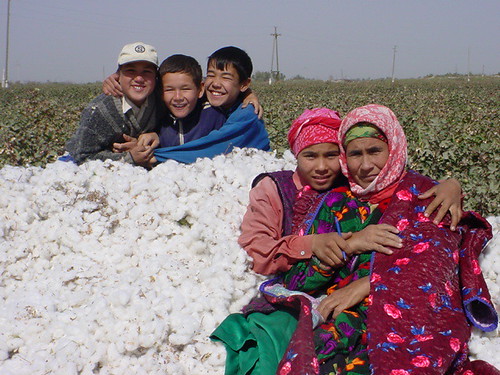 |
| Photo by Leo Deon |
Cotton
is also a huge source of pride (and destruction) of the country.
As a major cash crop,
high quality cotton fetches a high market price (Tommy Hilfiger and
Linens 'n Things use
Turkmen cotton for their products). Unfortunately, children
and teachers, doctors, nurses - everybody, are recruited every autumn
to leave
their classrooms and clinics to pick the cotton for months on end. Some
village schools would literally shut down from September
to November in order to reach the government quotas set for their
region. Also, it takes an incredible amount of water to irrigate the
cotton fields; inefficient water use throughout Central Asia accounts
for the strained relationships between individual countries, as well as
the dramatic shrinkage of the Aral Sea and other environmental
disasters.
|
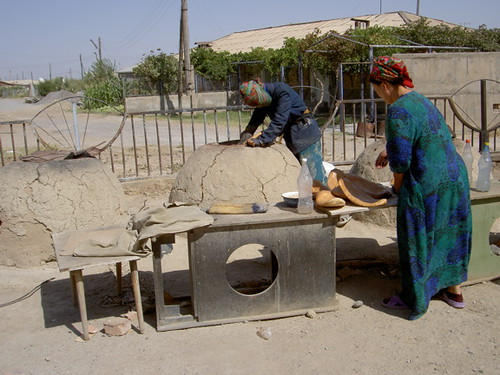 |
| Bread in Turkmen culture (and most other Central Asian cultures) is sacred. People eat bread at every meal, with butter and honey at breakfast, tea and pickled salads at lunch, and rice and lamb at dinner. |
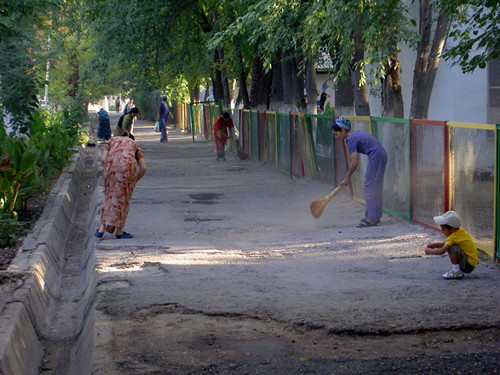 Every
morning (and throughout the day), women and young girls bend over
backwards to keep
their houses and sidewalks swept clean. It is no matter that the
country is a desert where sand and dirt are unavoidable.
|
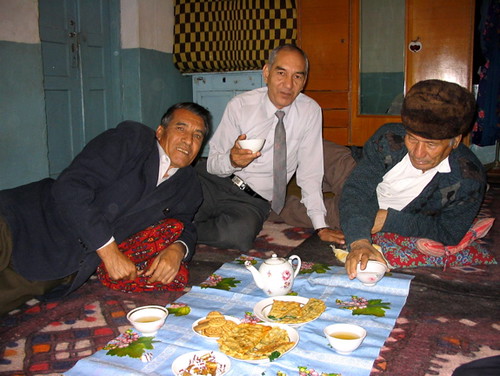 |
| Photo by Jane Bardon |
| Males (young and old), on the other hand, never have to do house work; they watch TV, talk politics and sports, drink tea (and vodka, during parties)... Not all males are like this, of course. Indeed, unemployment, alcoholism, drug addiction (heroin smuggled from Afghanistan), depression, and domestic abuse are very common amongst Turkmen male populations. Females have stepped up in this vacuum, leading their families and pursuing professional jobs at the same time. The girls in my classes were almost always smarter and more motivated than their male classmates. |
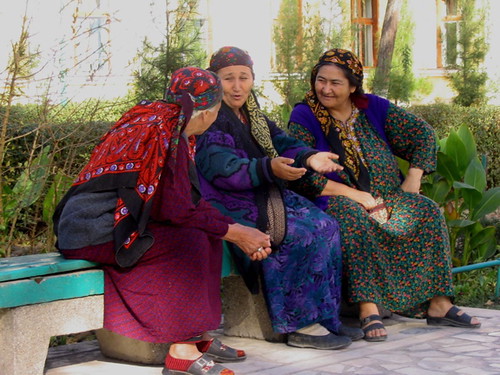 |
| Photo by Jane Bardon |
After all the housework was done, older women (dayzas) would find time as well to sit and gossip.
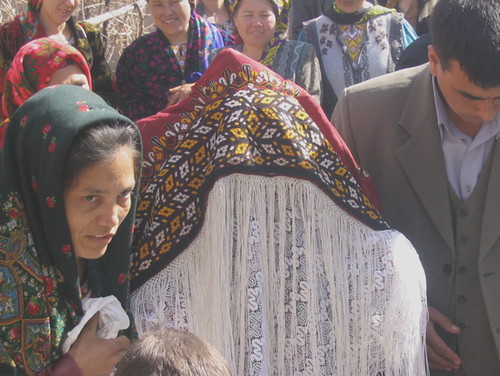 |
| Photo by Jane Bardon |
| This is the traditional dress of a Turkmen bride (red hood and white veil). No matter how hot the weather, the woman had to dress in layers upon layers of clothing and balance under the weight of gold, jewels, and camel rope (to fend against the evil eye). |
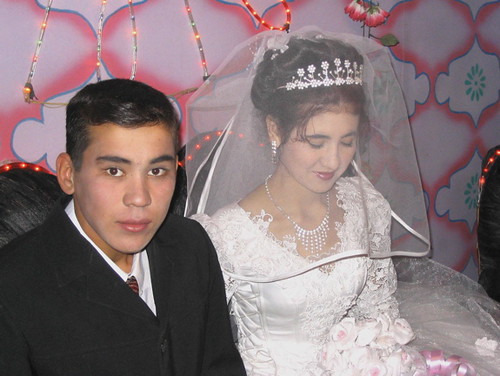 |
| Photo by Jane Bardon |
After
the traditional "Hoday Yoly" at the husband's family's house
(where a Mullah
would perform the religious ceremony), the
bride usually changed into a more western style dress, and the wedding
party would move into a banquet hall for more food and...
|
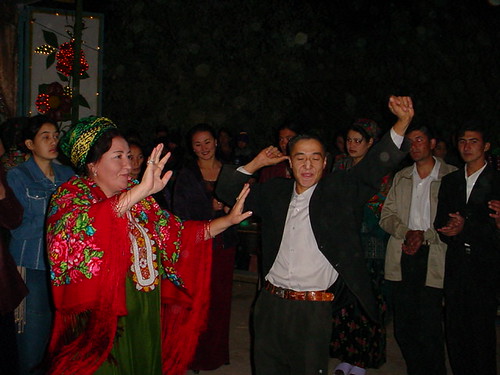 |
| Photo by Jane Bardon |
| DANCING!! Turkmen people LOVE to dance - from the smallest children to the oldest adults. Turkmen dance is an amazingly subtle exercise that usually involves a circle with everybody slowly rotating in one direction. Males and females only interacted by meeting each other in the center of the circle, turning around each other, but never touching, moving their arms and hands up and down in rhythm with the music. The music usually had a moderate-fast tempo, very heavy on the drums and synthesizer (usually recorded, but sometimes performed by a live singer, reed instrument, and dutar player). |
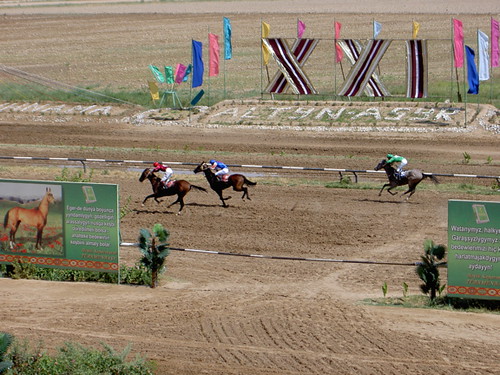 |
The
Turkmen horse (Ahal Teke) is highly prized as national treasures -
they
are relatives of the legendary Arabian horses that can run at great
speeds
across vast desert spaces without tiring.
|
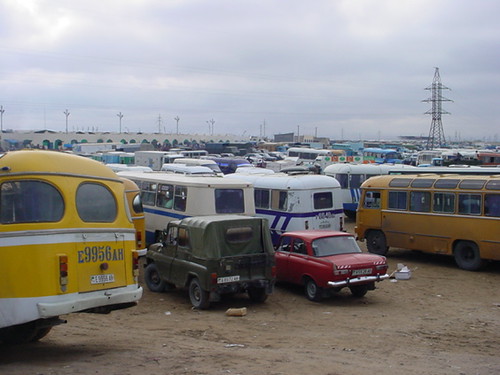 |
| Photo by Leo Deon |
| Now modern Turkmen drive Russian buses and sedans (usually the Lata) from the 1970s. Here they are parked out in front of Talkuchka, the biggest outdoor market in the country. |
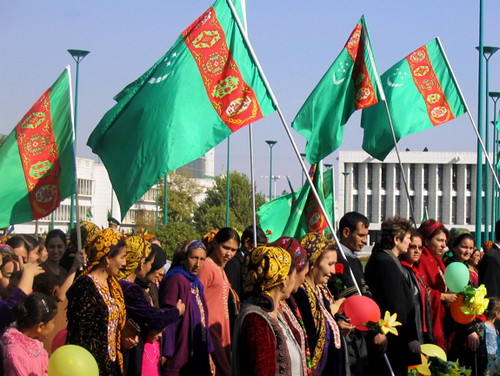 |
| Photo by Jane Bardon |
The
flag is a symbol of pride for Turkmenistan as an independent
and neutral country. The green represents the color of Islam, as
does the crescent moon. The five stars and five patterns on the
red strip represent the five velayats, or states, in the country.
The patterns are rug patterns that are unique for each region, relating
to the major tribes of people who have settled there a century ago.
|
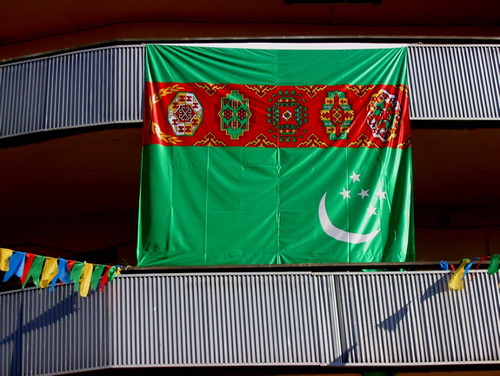 |
| Photo by Jane Bardon |
 |
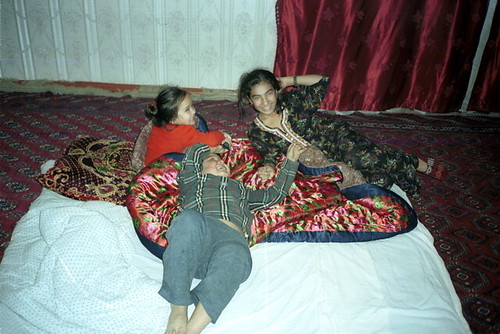 |
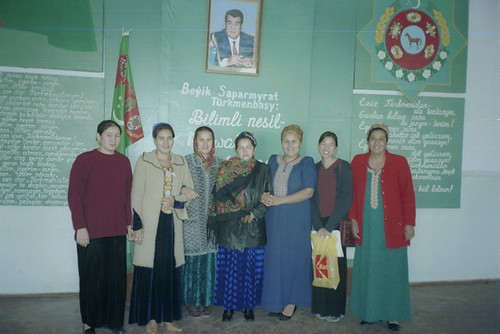 |
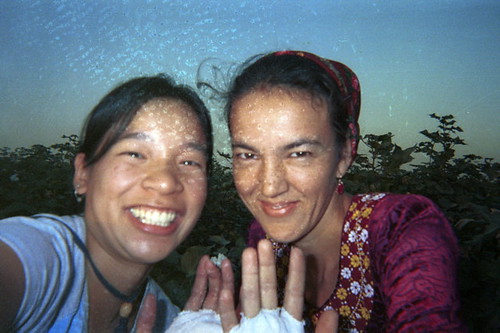 |
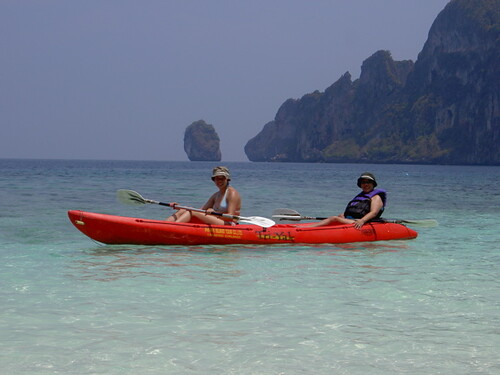 |
| TURKMENISTAN | DAILY LIFE | WORK | PEOPLE | VACATION |
Click here to go back to the index page.
Click here for additional resources about Turkmenistan and my Peace Corps experience.